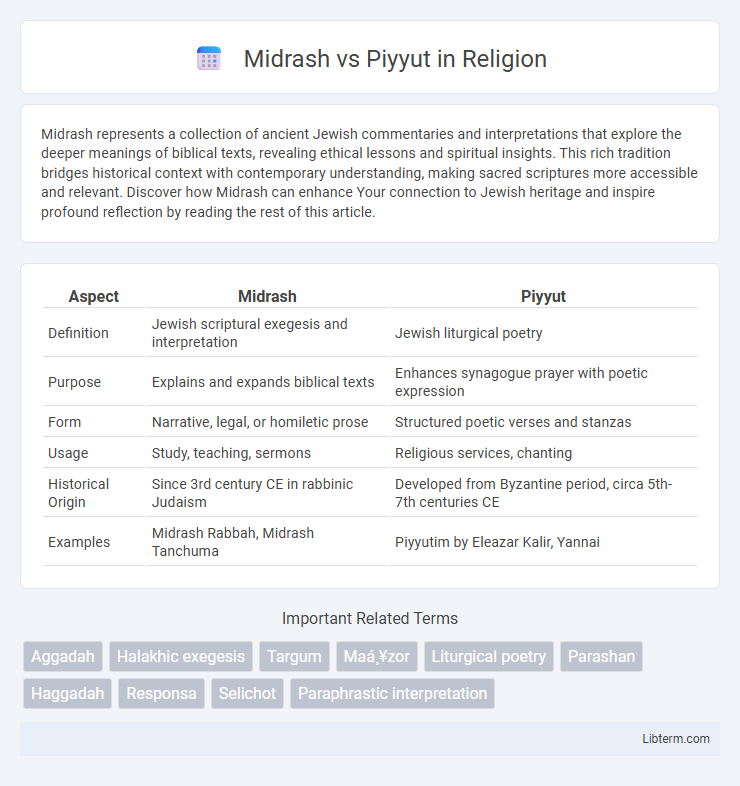Midrash represents a collection of ancient Jewish commentaries and interpretations that explore the deeper meanings of biblical texts, revealing ethical lessons and spiritual insights. This rich tradition bridges historical context with contemporary understanding, making sacred scriptures more accessible and relevant. Discover how Midrash can enhance Your connection to Jewish heritage and inspire profound reflection by reading the rest of this article.
Table of Comparison
| Aspect | Midrash | Piyyut |
|---|---|---|
| Definition | Jewish scriptural exegesis and interpretation | Jewish liturgical poetry |
| Purpose | Explains and expands biblical texts | Enhances synagogue prayer with poetic expression |
| Form | Narrative, legal, or homiletic prose | Structured poetic verses and stanzas |
| Usage | Study, teaching, sermons | Religious services, chanting |
| Historical Origin | Since 3rd century CE in rabbinic Judaism | Developed from Byzantine period, circa 5th-7th centuries CE |
| Examples | Midrash Rabbah, Midrash Tanchuma | Piyyutim by Eleazar Kalir, Yannai |
Introduction to Midrash and Piyyut
Midrash is a classical Jewish exegetical method and literary genre that interprets and expands biblical texts, providing narrative explanations and legal insights rooted in rabbinic tradition. Piyyut refers to liturgical poetry composed mainly between the 5th and 11th centuries, designed to enhance Jewish prayer services with rich poetic language and themes drawn from biblical motifs. Both Midrash and Piyyut represent foundational forms of Jewish creative expression, with Midrash emphasizing interpretative prose and Piyyut focusing on formalized, rhythmic poetry.
Historical Origins of Midrash
Midrash originates from ancient Jewish exegetical traditions dating back to the Second Temple period, primarily aimed at interpreting and expanding biblical texts through narrative and legal commentary. This genre contrasts with Piyyut, which emerged later in the early medieval period as liturgical poetry composed to enhance synagogue worship. Midrash serves as a foundational source for understanding Jewish law and theology, while Piyyut enriches religious practice through poetic expression.
Historical Development of Piyyut
Piyyut, a genre of Jewish liturgical poetry, emerged between the 5th and 8th centuries CE, evolving as a creative complement to biblical cantillation and synagogue worship. Unlike Midrash, which interprets and expands biblical texts through narrative and legal exegesis, Piyyut integrates biblical language and themes into structured poetic forms with rhythmic and melodic elements. Its historical development reflects the cultural and religious milieu of Late Antiquity, particularly in Palestine and the Land of Israel, where poets such as Yannai and Eleazar ben Kalir shaped its classical style, influencing Jewish liturgy for centuries.
Literary Structures: Midrash vs Piyyut
Midrash employs narrative and exegetical literary structures, utilizing storytelling, legal interpretations, and homiletic techniques to elucidate biblical texts and convey moral lessons. Piyyut, in contrast, features poetic structures with intricate meter, rhyme schemes, and rich imagery, designed for liturgical chanting and spiritual elevation. While Midrash focuses on expanding biblical narratives through prose, Piyyut emphasizes poetic embellishment to enhance religious worship.
Theological Roles in Jewish Tradition
Midrash serves as an exegetical tool within Jewish tradition, interpreting and expanding biblical texts to elucidate divine laws and ethical teachings, reinforcing theological concepts and shaping rabbinic discourse. Piyyut, as liturgical poetry, enhances communal worship by expressing theological themes such as God's mercy, covenant, and redemption, fostering spiritual connection and religious devotion. Both Midrash and Piyyut contribute distinct yet complementary roles in articulating Jewish theology: Midrash through doctrinal interpretation and Piyyut through emotive liturgical expression.
Key Functions in Synagogue Life
Midrash serves as a foundational exegetical tool in synagogue life, providing interpretive narratives that deepen the understanding of Torah texts during study and sermons. Piyyut, on the other hand, enriches the worship experience through liturgical poetry integrated into prayers, enhancing communal participation and spiritual reflection. Both Midrash and Piyyut play complementary roles, with Midrash focusing on textual exegesis and Piyyut on poetic expression, shaping the intellectual and emotional dimensions of synagogue services.
Linguistic Features and Styles
Midrash and Piyyut exhibit distinct linguistic features shaped by their purposes and forms; Midrash employs narrative prose with interpretive expansions rooted in Biblical Hebrew, often characterized by exegetical techniques and homiletic language. Piyyut, composed primarily in poetic meter with rhymes and rich parallelism, frequently integrates biblical allusions and employs archaic Hebrew, reflecting liturgical and emotional expressiveness. The stylistic contrast lies in Midrash's analytical prose style versus Piyyut's formalized, rhythmical, and evocative poetic structure.
Major Figures and Exemplary Texts
Midrash features major figures such as Rabbi Akiva and Rabbi Ishmael, whose exegetical methods shaped foundational texts like Midrash Rabbah and Midrash Tanchuma. Piyyut, a liturgical poetry tradition, highlights poets like Eleazar ben Qallir and Solomon ibn Gabirol, known for exemplary texts including "Keter Malkhut" and "Yedid Nefesh." These figures and their works embody distinct approaches: Midrash emphasizes biblical interpretation while Piyyut focuses on enhancing worship through poetic expression.
Impact on Jewish Thought and Culture
Midrash, as an exegetical method, profoundly shaped Jewish thought by providing interpretative narratives that deepened understanding of biblical texts and ethics. Piyyut, a genre of liturgical poetry, enriched Jewish culture by fostering communal spiritual expression and religious identity through music and recitation during worship. Both forms significantly influenced Jewish educational practices and cultural continuity, embedding theological concepts and collective memory into daily life.
Contemporary Relevance and Revival
Midrash remains a vital source for contemporary Jewish study, offering interpretative frameworks that enrich modern religious discourse and legal analysis. Piyyut, experiencing a revival in contemporary Jewish liturgical practice, fosters cultural connectivity through its poetic expressions that resonate in synagogue services and music. Both forms contribute to the dynamic preservation and evolution of Jewish spiritual identity in the 21st century.
Midrash Infographic

 libterm.com
libterm.com